Read Reviews
The Best Artificial Grass Brushes
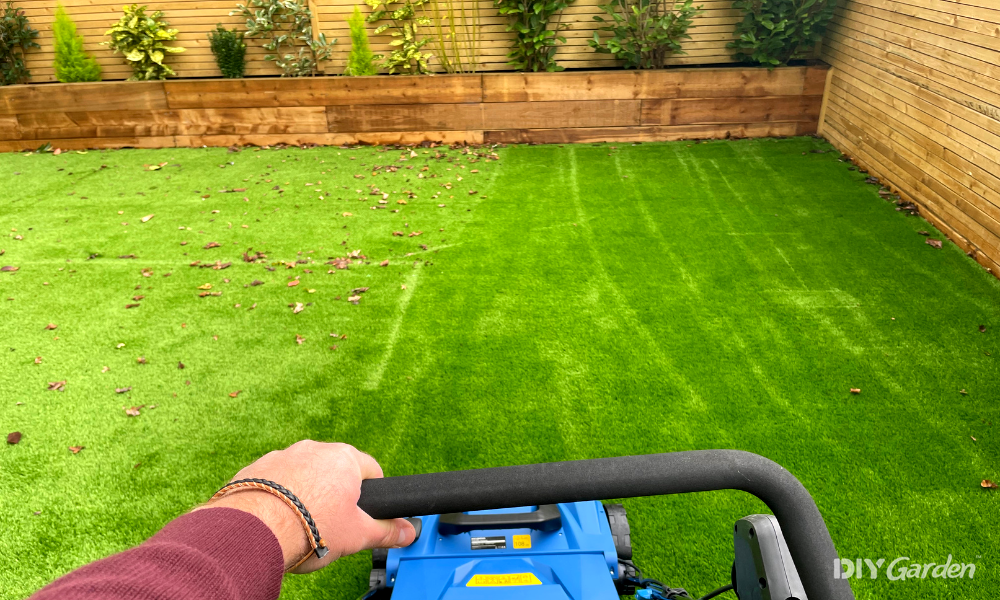
Is your artificial grass covered in leaves and debris? Perhaps it’s flat and looking a bit sorry for itself! That’s what happened to mine. So I set out to find the best artificial grass brush, to make it look new again. After hours of researching and testing, my top recommendation is the Hyundai HYSW1600E Artificial Grass Sweeper. Read on to see my full review (with photos) on how easy assembly was, how it performed, and if I think it’s good value for money.
-
Best artificial grass sweeper - Hyundai 1600w Artificial Lawn Grass Brush Sweeper
-
Cheaper alternative - Wolf 380mm Artificial Lawn Grass Brush Rake Electric
-
Best power brush - Turfmatic™ Artificial Grass Brush Electric Power Broom
-
Best manual brush - Spear & Jackson Astro Turf Brush
-
Best manual rake - Bergman Artificial Grass Astro Lawn Rake Brush
Artificial Grass Brush Reviews
1. Hyundai 1600w Artificial Lawn Grass Brush Sweeper
Best artificial grass sweeper
- 38 cm width makes it easy to cover large areas quickly
- Quick and easy to assemble in around 12 minutes
- When running, does not require a lot of force to push - feels lightweight and easy to manoeuvre
- Heavy-duty bristles effectively lift debris and fluff the grass upwards
- 5 adjustable sweeping heights so you can remove debris from the very bottom of the grass
- Can’t go right to the edges against walls and fences - there will be a gap of around 10 cm that gets left out
- It's loud - use ear defenders!
There aren’t many established brands in the artificial grass brush market, but there is one that stands out – Hyundai.
The fact that their petrol lawn is our top rated model, gave me a lot of confidence when purchasing the Hyundai HYSW1600E Artificial Grass Sweeper to test.
I had artificial grass laid in the summer of 2023 you see, and well, it was beginning to look quite messy.
Of course, it was absolutely pristine when it was first laid, but by November it was covered in wet leaves, soil overspill from the borders, and even broken water ballons from fun days gone by.
I’d done a lot of primary research before deciding on the Hyundai, but when it came to technical specification and existing customer feedback, it became clear this was the best model to go for.
But how good actually was it?
Assembly – 5/5
I love a product that’s easy to put together, and the Hyundai ticks that box. It took all of 12 minutes to assemble.
All you basically need to do is attach the handle (which is in 4 parts) to machine itself. There are some nice big chunky blue screws that are easy to turn, and all necessary tools are provided.
The instructions are clear and easy to follow, and as I say, within minutes I was wheeling it out to my garden.
Design – 5/5
When it comes to design, the first thing I want to mention is it’s weight. As I was wheeling it out, just how lightweight it is and how easy it is to manoeuver became apparent. It’s only 13.3kg, it’s got big wheels with smooth rotation, and a soft handle bar that’s well positioned.
There are also 3 different angle adjustments, 5 different sweeping heights, so finding the right position to suit you is easy. As a 6ft tall male, I preferred the position in height number 1.
Visually, it looks the part too. The vibrant blue that’s synonymous with Hyundai and the big logo on the front and on the 45 litre collection bag is reassuring. You feel like you’ve got a well built machine in your hands.
What’s surprising, and that you’ll notice from the pictures is how much shorter artificial grass brushes are compared to lawn mowers. It’s a bit like having a smart car instead of a saloon! But of course, inside there is simply the power brush, so it doesn’t need to mimic the size of a lawn mower.
Overall I think it looks the part, and because of its compact size, it’s easy to store too. Mine fits nicely in my outdoor storage box.
Performance – 5/5
Next, let’s get into the meat and potatoes! How well does it actually clean…
The best way I can put it is that it’ll make your artificial grass look like new again.
It lifts the vast majority of debris in its way, runs it through the power brush and shoots it straight into the collection bag behind it. It’s really quite impressive and satisfying to use!
It’s also worth noting that it gives your artificial grass a bit of a lift too. This is really helpful if yours has been flattened quite a lot. It almost works like how a vacuum lifts carpet.
There’s a couple of points though that I want you to know about:
Firstly, as your collection bag becomes full, debris can start to come out as there’s a slight gap between the unit and the bag. My advice is to simply empty it once you notice that happening.
Secondly, much like a lawn mower, this machine can’t get right to the edges. It’s got a nice wide 38cm sweeping width, but you still won’t be able to just run it along your borders and clean everything.
How I overcame this was to using an outdoor brush, to move the leaves and debris away from the edges, so that the machine could then suck it up. You might find this a bit annoying, but it’s the same with all models.
I haven’t marked my scoring down for either of these points, because I think they’re both pretty fair and normal limitations. I just wanted to make you aware of them, so you’re in the know.
Safety – 4.5/5
When it comes to safety, there’s a few things you need to know about the Hyundai.
It’s got a nice long 10m power cable, but more importantly, it’s orange and easy to see. I hate it when machines have black cables that are easily hidden. So this definitely scores some points for this.
It’s also got a bright red start button that needs to be pressed alongside pulling the trigger under the handlebar before it’ll start. This is another important safety feature.
However, when it comes to noise, this machine is a loud. The noise genuinely surprised me, as I was thinking it would be on par with a lawn mower. It’s not. It’s 108dB compared to about 80-90db for a lawn mower. Credit to Hyundai though, there are big yellow safety labels on the top of the machine, so I feel they’re done all they can to warn users. My advice is to simply make sure you’re wearing ear defenders before you start using it.
Finally, I just want to discuss the power. As soon as you turn it on, you’ll feel the propulsion of the machine. It wants to go! So just be aware of that, particularly if you have mobility issues. I don’t want it to take you by surprise.
Value for Money – 5/5
For me, value for money isn’t all about price, it’s about how well the product does it’s job, in comparison to the price. And with the Hyundai HYSW1600E Artificial Grass Sweeper I’m really impressed with how it performed and happy with my purchase.
Although I’ve highlighted a couple of things you should be aware of with this model, there aren’t actually any real negatives with it!
I do of course plan to use it for years to come, so if any issues arise in the future, I’ll update this review. But for now, it definitely gets my recommendation as the best artificial grass brush to buy.
Did you find this review helpful?
2. Wolf 380mm Artificial Lawn Grass Brush Rake Electric
Cheaper alternative
- Picks up small and large particles like dust, twigs and small stones
- A very powerful model
- Helps artificial grass to stand up straight which makes lawn look fuller
- Very easy to put together in around 20 minutes
- Can be used to stripe the lawn
- Doesn’t reach the edges of the grass so approximately 15 cm will be left untouched
- May be too powerful for grass that isn’t firmly secured down
The Wolf Artificial Lawn Brush works deep into artificial grass, picking out pieces of fine debris that you might not even know were in there.
With a width of 38 cm, this artificial grass brush works efficiently across larger stretches of artificial lawn. The wide rotating brush has a diameter of 12.8 cm and is powered by a 1600 W motor. It easily pulls pet hair, dust, twigs and debris out from artificial grass. Plus, it not only removes these particles, but it also fluffs up the lawn, refreshing any flat, downtrodden grass.
Be aware that this brush is very powerful. Whilst this is generally great news for cleaning the lawn, you should make sure that all artificial grass is firmly secured before using it.
There are five adjustable brush heights overall, ranging from -12 mm to 6 mm. Not only does this help clean artificial grass, but by using this lawn brush in different directions you can also use it to create a striped effect over the surface.
With a 45 L grass collection bag, this artificial grass vacuum can be used as your primary lawn-cleaning tool. The only time that an additional garden vacuum might be required is at the edges of the lawn – this brush can’t clean right up against fences or walls.
It’s straightforward to put this sweeper together and assembly takes around 20 minutes. The handles fold down for easy storage in small sheds or garages. The 10 m cable is suitable for small/medium lawns but may require an extension in bigger areas.
Overall, this is a very powerful machine and one of the best brushes for artificial grass in terms of versatility. It will easily remove both small and large particles from the lawn.
Did you find this review helpful?
3. Turfmatic™ Artificial Grass Brush Electric Power Broom
Best power brush
- The widest lawn brush at 60 cm wide, can quickly cover large areas
- Will brush right to the edges of the lawn even if there are walls and fences
- Can be used during installation of artificial turf to lift grass from its compacted state
- Ergonomic handles make it easy to remain in control of the machine
- Reasonably heavy machine at 18 kg
- Due to the wide width it can’t be easily manoeuvred in narrow areas
The Turfmatic™ Artificial Grass Brush Electric Power Broom is the best electric brush for medium/large gardens with a lot of borders and boundaries. It boasts a wide 60 cm broom head that allows you to cover larger areas in a fraction of the time you would with a traditional broom.
Plus, thanks to the handheld design of this brush, it can get right up to the edges of an artificial grass lawn. Many other artificial grass brooms are unable to get right up against boundary lines because the wheels get in the way.
The 1500 W motor and 200 rpm working speed enables it to get deep into the turf to remove debris. Once this artificial lawn sweeper has removed the debris, it will need to be vacuumed separately as this brush has no hoover function.
Ideal for freshly laid artificial turf, this artificial lawn brush can also lift the grass strands from their compacted state, fluffing them up and making them look more realistic. It’s suitable for both regular maintenance jobs and new installs, making it better value for money than a lot of other brooms on the market.
With an alloy steel body and guard, this brush also feels good quality. The 10 m cable, although not overly long, means you should be able to get around most medium size lawns. For larger areas, you’ll likely need an extension.
At 18 kg, this brush is one of the heaviest featured here. It remains easy to use, but the weight might be off putting for some users.
Overall, thanks to its wide size and ability to get close to edges, this is the best artificial lawn brush for medium/large gardens that have lots of boundary lines.
Did you find this review helpful?
4. Spear & Jackson Astro Turf Brush[ SAVE 10% ]
Best manual brush
- Lift s the pile of grass upwards without causing damage
- Pick up even small pieces of debris and animal hair
- Adjustable handle is comfortable for users of all heights to use
- Easy to sweep close to the edges of the lawn
- Has a width of 35 cm which makes it easy to manoeuvre around pots, flowerbeds and other obstacles
- Handle has noticeably more flex when used at full extension
If you’re fed up of a tired-looking lawn, the Spear & Jackson Astro Brush is capable of refreshing artificial grass so that it looks new again.
Even if it’s been several years since your Astro turf was laid, this artificial grass broom runs through and lifts all the garden debris, whilst also encouraging artificial turf to stand up and stop looking so downtrodden.
It has curved bristles that help comb through the lawn’s strands as well as get into corners and around obstacles like flowerpots. Even where leaf blowers and lawn vacuums fail, this Astro Turf Brush shines through.
Whilst vacuums can hoover up larger items like leaves, they don’t always have success against smaller items or animal fur on artificial grass. This artificial grass broom, however, picks up dog and cat hair and stops it from matting up the lawn.
Basically, if there is debris clogging up your faux lawn, this is one of the best brushes for artificial grass and Astro turf to go for. One of its main advantages is how well it cleans artificial grass, but it is also durable, easy to store, and comfortable to use, which are other bonuses.
The telescopic handle uses a twist-and-click mechanism to change the length, and it can be collapsed down for easier storage. For the most part, the handle is strong and durable; however, it does have a bit of flex when extended to its full length.
Overall, this Spear & Jackson artificial grass broom works well with very few disadvantages. It can both clear artificial grass and fluff up the pile, and it offers great value for money as well.
Did you find this review helpful?
5. Bergman Artificial Grass Astro Lawn Rake Brush
Best manual rake
- Simple, affordable and very low maintenance
- Polyamide filament bristles remove debris but don’t damage grass
- Telescopic handle can accommodate different height users
- Can be easily taken apart and collapsed down for storage
- Large 45 cm width quickly covers small/medium spaces
- Time consuming to use across larger areas
- Has little effect with removing moss
- Debris, dust and pet hair will still need to be vacuumed to remove them from the surface
This lightweight Bergman Artificial Grass Astro Lawn Rake Brush offers a simple yet effective way to clean small/medium lawns with artificial grass.
With high-grade polyamide filament bristles, this artificial grass rake gently lifts grass tufts which have been flattened by footfall. Given that it can improve the appearance of the grass blades without causing damage, it’s also a good choice if you are concerned that electric brushes may be too powerful for your artificial grass lawn.
Thanks to the long length of the brush’s bristles, it can clean to the ‘roots’ of artificial grass and remove leaves, stones and garden debris. However, if you have a lot of moss growing on your artificial turf, you may need a more heavy-duty tool. Overall, this brush is a good choice for regular garden maintenance.
Lightweight and easy to use, this artificial grass rake allows for a comfortable working position thanks to the telescopic twist-and-lock handle. The handle can be extended from 78 cm to 130 cm to suit users of different heights (you might even be able to persuade the kids to lend you a hand!). The sweeping width of 45 cm means that this brush covers quite a wide area when working.
As you can imagine, thanks to its narrow design, this artificial grass rake is very easy to store so it’s a good choice for anyone short on space. The handle can be shortened, and the brush head removed, so it takes up very little room.
If you’re on a tighter budget, this is the best brush for artificial grass. It still effectively removes debris and lifts the pile on artificial grass, but it’s much less of an investment than electric models. It will be best suited to smaller lawns, but it will also be useful for tidying the edges of larger gardens.
Did you find this review helpful?
Product Tester
How to Choose the Best Brush for Artificial Grass and Astro Turf
Artificial grass can be a lot easier to look after than the real deal, but keeping on top of maintenance and cleaning is key when it comes to keeping a thick, luscious-looking artificial lawn.
Whilst it’s true that artificial grass doesn’t need mowing, it still needs a bit of attention sometimes; anything that’s outside 24/7, exposed to the elements, is bound to experience some wear and tear.
Fortunately, looking after artificial grass is simple – forget lawn mowers, grass seed and fertiliser, all you really need is a good brush!
Choosing the best brush for artificial grass will depend on your budget, grass length, and the type of debris causing problems. The following information will give you more of an idea about what to look out for:
Four Steps Towards Maintaining Artificial Grass
First, let’s look at the most important aspects of maintaining artificial grass.
Keep it Clean
Artificial grass is generally very easy to keep clean, with rainfall doing a lot of the work for us. However, during a dry period, hosing down artificial turf lawn is a good option and can help remove stubborn dirt, dust and debris.
An artificial turf brush will also help remove dirt. It’s also useful to use a brush before hosing the lawn, to loosen any stubborn dirt first.
If your lawn is especially dirty, you may find it useful to use a specially-made artificial grass cleaner rather than water alone.
Remove Leaves and Debris on a Regular Basis
Particularly in the autumn months, artificial turf can end up trapping a lot of leaves and debris. Besides looking messy, this can also lead to weed growth over time if it’s allowed to build up.
Using a cordless leaf blower, an artificial grass rake or an artificial grass broom can all help rid your lawn of leaves and debris.
Also, if you have a dog or a cat, you will find that their hair also gets trapped in artificial grass. This can be harder to remove with a leaf blower or garden vacuum, and is often most effectively treated with a rake or broom designed specifically for artificial grass.
Regularly Brush the Fibres
Over time, artificial grass can start to look a little flat and lacklustre. This is due to wear, causing the grass strands to get flattened. It’s easily rectified by using a brush designed for artificial turf.
Brushing the grass in the opposite direction of the fibres will encourage them to stand up, ‘fluffing’ the grass upwards can help it look revitalised and new.
Prevent Weeds from Growing
Whilst weed growth on artificial lawns isn’t nearly as much of an issue as it can be on regular lawns, seeds can still germinate within the fibres. You may find moss growing on your artificial lawn which can be removed by rakes and brushed designed for artificial grass.
Weeds on your artificial lawn can usually be removed by hand, as they will have only grown on the surface of the artificial turf and not developed deep roots.
As a last resort, it is possible to use some weed killers and moss killers on artificial grass – but make sure they’re suitable first.
Electric and Manual Lawn Brushes
As you’ll have seen from the products on this page, there are manual brushes and rakes available for sweeping artificial grass, as well as electric machines.
Manual rakes and brushes are better suited to small patches of lawn. They do an effective job and are great value for money. However, they’re slow going so you won’t want to be using one across a large expanse of artificial lawn. This is also true because you often need to go over the lawn a second time with an artificial grass vacuum, after using a manual rake or brush, to suck up the dislodged debris.
Here we’ll look at each type of tool in more detail:
Manual Rakes and Brushes
Artificial-lawn brushes look similar to a standard household broom. They have bristles that are compatible with artificial grass and won’t cause damage to grass fibres. Compared to rakes, brushes have a lot of bristles and are useful for removing smaller pieces of dirt and debris from the lawn, as well as larger leaves.
Artificial-lawn rakes have fewer bristles/tines. They often have just one or two rows of tines. These are particularly useful for collecting larger pieces of debris like leaves and twigs, but they can end up flicking small pieces of dirt around, instead of rounding them up. Rakes are generally better at getting deeper into the grass, closer to the base, as the fewer tines provide more accuracy.
Rakes can be used to dislodge debris on artificial turf, making it easier to collect with a lawn hoover.
For the most part, rakes and brooms are most suited to small lawns with artificial turf. However, if you have a large lawn, you may still want an artificial grass rake in order to reach the edges where electric powered brushes can’t fit.
Both styles can be used to brush artificial grass in the opposite direction so that it stands up better.
Electric Powered Brushes
Originally, electric powered brushes were most commonly used in professional environments. Nowadays, there’s a range on the market suitable for domestic gardens. Electric powered brushes make it much quicker to clean a medium/large artificial lawn. For smaller artificial lawns they’re also very effective, but you may decide that they’re not worth the expenditure. Electric powered brushes work using a motor that rotates a rolling bristle brush.
Mains-powered brushes are powerful and capable of removing small particles, like dust and dirt, as well as larger particles, likes twigs and small stones, from the lawn. They can even be used to create aesthetically-pleasing stripes across the lawn.
There are pros and cons to using an electric brush over a manual brush. These are some of the advantages:
- Far less labour intensive – you’ll be able to sweep your artificial lawn in a fraction of the time
- Most are self propelled and require much less physical effort
- Many have a box attached which collects the debris, dust and dirt meaning there’s no need to vacuum the lawn afterwards
- More effective than many brushes – have different sweeping heights to accommodate different types of artificial lawns
- Most are very versatile and can also be used to clean patios, decking and paving
These are some of the disadvantages:
- Although electric powered brushes save you time, they are a lot more expensive
- While generally compact, they still take up a lot more space in a garden shed than a traditional brush
- Noisier and less eco-friendly than traditional brushes
- They are heavier than standard brushes
Choosing the Best Artificial Lawn Brush
Bristle Material and Length
Artificial brushes usually have synthetic bristles. Metal or wire bristles will damage the fibres of your artificial lawn. Bristles made from polyamide or nylon work well on artificial grass. They are sufficiently stiff to remove debris without damaging the lawn.
Brushes for artificial turf can have either straight or curved bristles. Straighter bristles make it easier to sweep up large pieces of debris in open areas, while curved bristles are designed for awkward areas and can capture smaller bits of debris too.
Bristles on brushes are not a uniform length, and if you will want to make sure that your artificial grass and the bristles on your brush are roughly the same length. This will ensure that all of the debris gets caught.
Synthetic bristles can be used on both wet and dry surfaces and they’re easy to clean after use if needed.
Sweeping Width
Wider brushes are better for covering large gardens quickly, meaning the job takes less time. However, if you have a lot of obstacles in your garden, or smaller sections, you may find a wide brush inconvenient.
Standard brushes for artificial grass can range from around 30 – 45 cm in width.
Wide brushes may be harder to store, but on manual rakes/brooms the head can often detach from the handle for easier storage.
Artificial Grass Brush FAQs
Artificial grass is loved for its low maintenance, so there’s no need to go overboard when it comes to sweeping.
During the majority of the year, you only need to brush your artificial lawn once a month. In autumn, if there’s a lot of debris you may need to brush more frequently. Similarly, when the lawn gets more use in summer it may benefit from a few extra brushes.
Brushing your lawn will both remove debris and help the grass to stand up straighter, so if you’ve got a special occasion coming up, you may want to give your lawn a quick once over.
It’s also important to note that pet owners may need to brush their lawn more often as animal hair can get easily caught in the artificial grass.
Artificial grass can start looking a little tired if it’s not well maintained, but this doesn’t mean it can’t be salvaged.
Regularly brushing the grass with a specially made broom will encourage the bristles to rise – leading to a newer looking lawn.
Rinsing and cleaning your lawn on a regular basis is also important. If you live in a particularly dry area, you may need to use a hose. Don’t be tempted to use a power washer as this can damage the fibres.
Non-toxic turf cleaners can help remove bacteria and reduce the build up of debris. There are products available that are specifically designed for artificial grass.
No, you should not pressure wash Astro turf.
While artificial grass is tough, it’s not that tough. Even standard home pressure washers are very powerful, and can damage the fibres. Use a hose instead – it’ll get the job done just the same, whilst protecting your grass.
Sand infill is sometimes brushed into artificial grass to improve stability and support the fibres. The issue with artificial turf is that it weakens and flattens easily. With repeated footfall, artificial grass can quickly look lifeless. Sand adds the necessary support to keep the blades upright.
The two main downsides of using sand infill are that it clogs draining holes and it can make a mess. If kids and pets like to play on the lawn, you may find that they come inside covered in sand! Sand infill can also encourage weeds to grow.
Whilst many people choose to brush infill into their lawns, many manufacturers are now producing grass that claims to require no infill during installation. A lot of artificial grass products are now described as ‘non-infill’.
Using an artificial brush can also help encourage grass blades to adopt a more upright position.
There are specific artificial grass vacuums on the market for artificial turf. Using a standard indoor vacuum can easily damage artificial grass.
A garden vacuum will be a lot gentler and will be able to pick up dust and debris from artificial grass without damaging its fibres.
If you have applied sand infill to your artificial lawn during installation, the artificial grass vacuum will likely suck this up. This means that you’ll need to top up the infill, which can be expensive. For this reason, if your artificial lawn has infill, it’s recommended that you avoid using a vacuum.
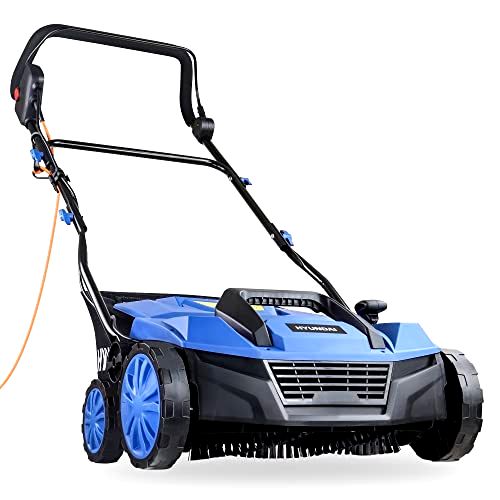
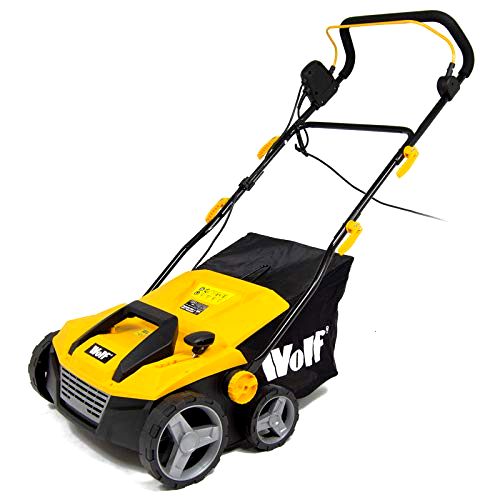
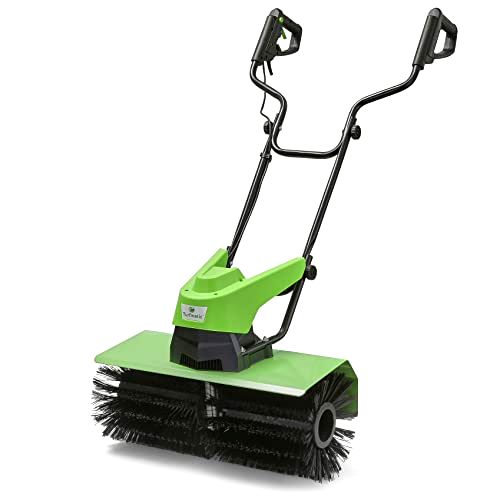
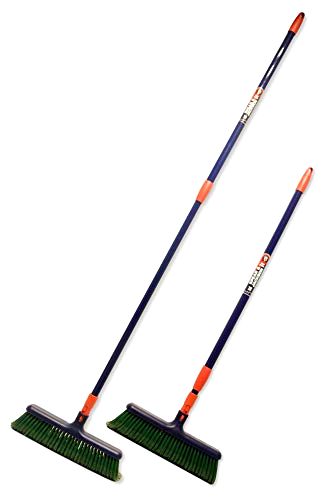
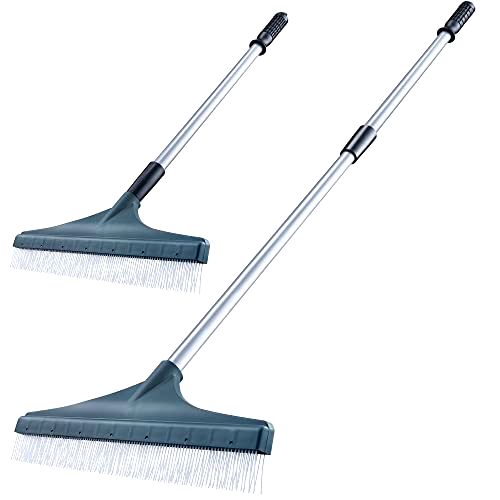
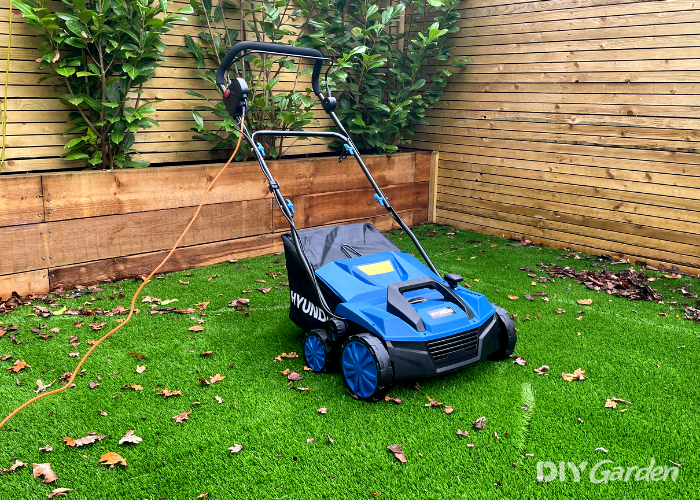
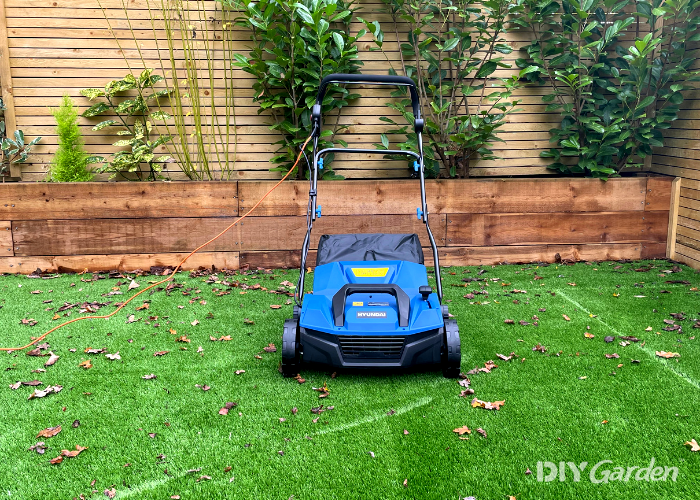
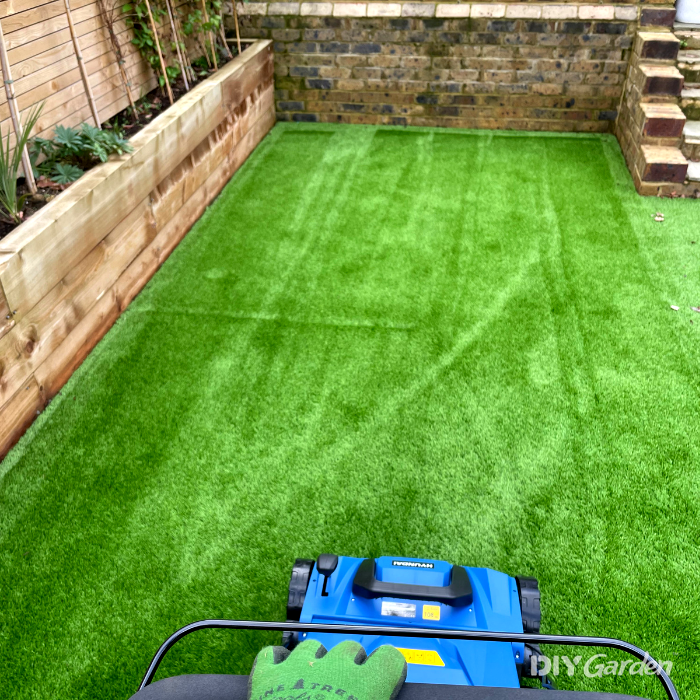
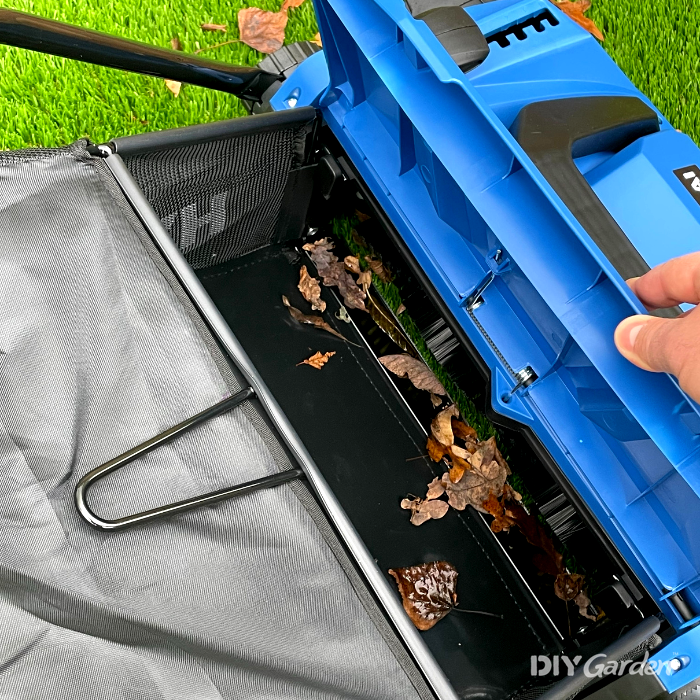
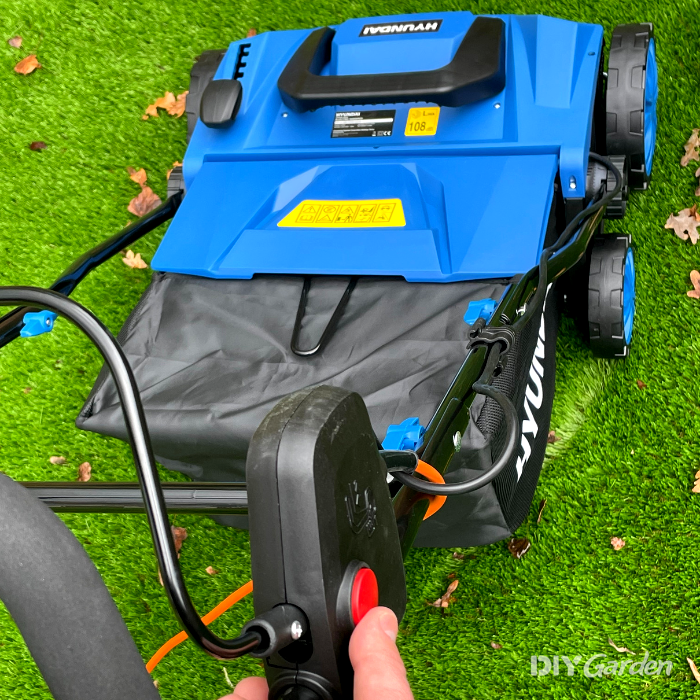

Share